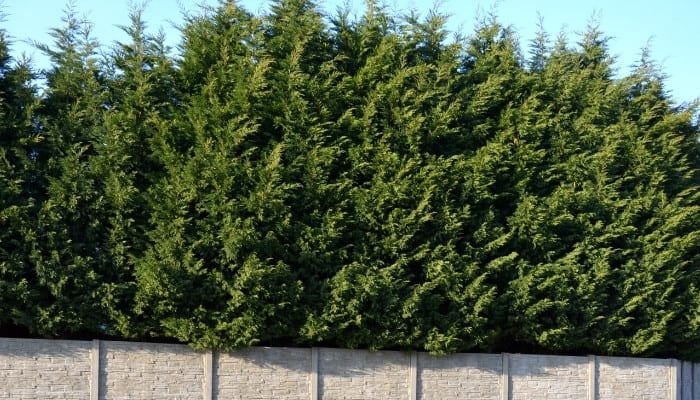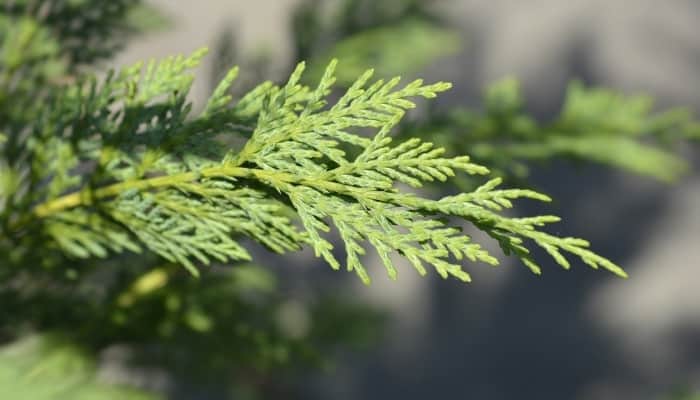The Leyland cypress, also known as Leylandii, is widely recognized for its tall stature and usefulness in creating privacy for yards. In some cases, it has even been known to cause disputes between neighbors.
Leyland trees grow around three to four feet every year, which can cause them to invade other yards. While the tree may be invasive to other yards, does that make the roots invasive as well?
Are Leylandii roots invasive? Although the visible part of the Leyland cypress may be invasive of neighboring yards, its roots are not invasive and will not penetrate any buildings. Leylandii roots are shallow, spreading out horizontally in search of moisture and nutrients, but they are not very strong.
If you’re still wondering about the roots themselves or how and where to plant them, here’s a breakdown of everything you need to know.
Leylandii Roots
Leylandii roots are shallow and not very deep, taking up a ton of moisture from the soil. They are typically not invasive either.
How Leylandii Roots Grow
The location and type of soil the roots are in will determine the roots’ length and depth. Leylandii roots grow fast and spread fast, but they do not grow very deep.
They prefer to remain shallow, spreading out horizontally instead of growing down.
Do Leylandii Have Big Roots?
The root size can vary based on the height of the Leylandii hedge.
If you allow a hedge to grow tall, the roots will accommodate the size and grow right along with it, typically growing in length equal to half or more than the tree’s height.
Do Leylandii Have Long Roots?
The length of Leylandii roots is typically a little less than the height of the tree. So taller Leylandii will result in longer roots.
Do Leylandii Have Deep Roots?
While the roots do grow with the upper half of the tree, the root system is shallow, making the tree easy to topple (if it is tall) and susceptible to tree diseases such as cankers.
Do Leylandii Have Tap Roots?
Because the root system is so shallow, Leylandii do not typically have a main taproot. Instead, the roots fan out and spread wider as the tree grows.
How Far Do Leylandii Roots Spread?
Leylandii roots typically do spread if the hedge or tree is allowed to continue growing. Although the roots do not penetrate or disrupt building structures, they can still be lengthy and wide.
Oftentimes, the roots will reach lengths equal to half or more of the tree’s height.
How Invasive Are the Roots of Leylandii?
Leylandii roots aren’t invasive below the ground compared to the parts of it that are above ground.
While they can grow very tall, the roots themselves will not penetrate any buildings or houses.
Do Leylandii Roots Cause Problems?
The short answer is yes, depending on how well you manage your Leylandii tree or hedge. The Leyland Cypress grows extremely fast and can get out of control quickly.
Living in a location where you are surrounded by neighbors can cause disputes over the space Leylandii trees use. You may love your Leylandii hedge, but your neighbors might not if it grows too tall.
Leylandii roots are absorbent and will soak up most of the moisture (and nutrients) in the soil, which is bad news for other plants or grass.
Not all trees can cause this problem, but houses near a Leylandii may be subject to sinking since its roots can cause clay soil to shrink (which may cause the ground to start sinking).
Damage to properties usually happens with buildings on clay soils.
Do Leylandii Roots Grow Back?
Usually, when you kill the roots or the tree, Leylandii will not grow back. So, if you decide to kill your Leylandii, know that there is no going back (unless you buy another one).
Things to Consider Before Planting Leylandii

Leylandii trees are among the fastest growing conifers. If you don’t properly maintain these plants, they can get out of control quickly.
You should consider the following:
- Where you are living (larger spaces are better for growth).
- Your purpose for planting.
- Whether you have neighbors (they may not think so highly of your gigantic tree).
- How much sunlight your yard has access to.
Leylandii can be great for privacy, but make sure you are in a location that can help them thrive.
Killing Leylandii Roots
Using salt to rid your yard of Leylandii will also kill nearby vegetation and plants, so it is not the best method to use.
To effectively kill the tree and the roots, use the method of ringbarking and foliar spray.
With ringbarking, you take an ax and remove a ring of bark, which stops the nutrients from getting to the roots. Similarly, the foliar spray will kill the root system of a young Leylandii tree.
Related Questions:
How Far Should a Leylandii Be From a House?
Normally, Leylandii grows 3 feet a year, so make sure you are planting it far enough away from your home, your neighbor’s fence, and powerlines.
A good rule of thumb is to plant it where it has 10 to 15 feet of room to grow. Consider planting your Leylandii farther from the house if your goal is to have taller hedges.
How To Get Rid of Leylandii Roots?
You can spray or inject the ground around the tree with salt water to get to the root system. This kills the entire plant, but it can also kill surrounding plants.
Also, using a ringbarking technique or herbicides will rob the roots of nutrients, causing them to wither and die.
Conclusion
As a fast-growing coniferous tree, the Leyland Cypress provides a fast solution if you want a more attractive-looking way to build privacy in your yard.
While the height of these trees can be problematic, the roots themselves are not too large and aren’t harmful to structures.
If you are unhappy with your Leylandii tree, simply using a ringbarking technique or spraying it with herbicides can kill it.
When planting your tree, make sure the soil is rich, the space has sunlight, and your yard has plenty of space for growing the tree to its desired height.

